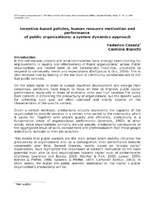Incentive-based policies, human resource motivation and performance of public organizations: a system dynamics approach
Abstract
This paper tries to analyse - through a System Dynamics approach - positive and negative effects caused by human resources' (de)motivation in terms of productivity and quality of performance in public organizations. We will use 'System Dynamics' as a methodology capable in studying and managing complex systems characterized by uncertainty and dynamism, such as public organizations. Motivation is here meant as an inclination to fill a gap between a desired and an actual level of productivity; this can be achieved through a set of policies aimed to encourage, sustain and address human resources' behaviour in a working setting. As a consequence of such policies, public organizations would increase their productivity and effectiveness, thereby improving the level of wealth to the community they work for. But how does work motivation influence public organizations productivity? Do workers, if motivated, become more productive both in quantitative and qualitative terms? How to relate workers' perception about motivation and their positive or negative reaction at work? Is it possible, and how, to use motivation in order to improve the organization's performance over time? Answering the above questions is very difficult; however, the aim of this paper is to investigate and link - through a System Dynamics approach - those variables which affect both motivation and productivity. Particularly, the paper is virtually divided in four sections: in the first one a description of the observed problematic behaviour of public organizations' productivity is introduced by considering the resistance that specific motivational policies show over time. Those policies are basically related to the performance that public workers as a whole express during a given time interval. The second section contains the work hypothesis which consists in a dynamic model structure able to replicate the problematic behaviour on the basis of the relations among those significant variables affecting both productivity and motivation of public workers. Then, the third one provides the runs of such model and the consequent explanation of how it replicates the observed behaviour. Finally, in the last section a set of policies is introduced and commented in order to suggest possible solutions and future scenarios that could stem from the application of the model's finding in decision making processes. In conclusion, the key-words of the paper are: Productivity, Motivation, Human Resources, Public Organizations, System Dynamics.


